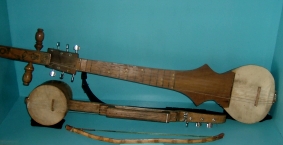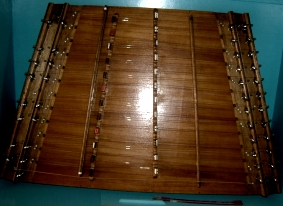
Tibet has a unique heritage of dance and music. The famous Regent of the 5th Dalai Lama (De-Srid Sang-Gyas Gyatsho) wrote a book on music: the Mig-yid Nang-bai Ga-Ton. Sakya Pendita also wrote a book of musical aphoristic verse: the Rol-Moi Tenchos. Despite these books, none of the famous traditional musicians of Tibet studied the theory of music.
Mr. Jampel Kaldhen (our Principal) has done extensive research on Tibetan music for more than a decade, and has written a book on Theoretical Tibetan Music. The book, which reflects the richness of Tibetan music, is in three parts: (1) musical terms, (2) Notation and scales and (3) Lyrics. It is being used as text for cultural classes at the school.
To overcome some of the limitations of Tibetan musical instruments, and the lack of musical notations, Mr. Jampel Kaldhen has also developed some Tibetan music innovations. For example, the dulcimer(yangzing) used by the Tibetan musicians is very limited in pitch. To improve the pitch he has invented an instrument with twenty-one double strings: the Gyal-bai Gayud-sNgen (pictured on the left).
Another innovation used by the school is a five stringed lute: the Doe-yon Nga Nga. It is modified from the four stringed lute used by the seventeenth century musicians introduced by De-Srid Sang-Gyas Gyatsho. Mr Kaldhen has also developed a three stringed bow (the Piwang ' dG'-'Khyil Ngaro') based on the De-Srid Sang-Gyas Gyatsho's four stringed lute.
Mr. Jampel Kaldhen (our Principal) has done extensive research on Tibetan music for more than a decade, and has written a book on Theoretical Tibetan Music. The book, which reflects the richness of Tibetan music, is in three parts: (1) musical terms, (2) Notation and scales and (3) Lyrics. It is being used as text for cultural classes at the school.
To overcome some of the limitations of Tibetan musical instruments, and the lack of musical notations, Mr. Jampel Kaldhen has also developed some Tibetan music innovations. For example, the dulcimer(yangzing) used by the Tibetan musicians is very limited in pitch. To improve the pitch he has invented an instrument with twenty-one double strings: the Gyal-bai Gayud-sNgen (pictured on the left).
Another innovation used by the school is a five stringed lute: the Doe-yon Nga Nga. It is modified from the four stringed lute used by the seventeenth century musicians introduced by De-Srid Sang-Gyas Gyatsho. Mr Kaldhen has also developed a three stringed bow (the Piwang ' dG'-'Khyil Ngaro') based on the De-Srid Sang-Gyas Gyatsho's four stringed lute.
SOME OF OUR INNOVATIONS

Doe-yon Nga-Nga (The 5 Stringed Lute)
dG'-'Khyil Ngaro (The 3 Stringed Piwang)
dG'-'Khyil Ngaro (The 3 Stringed Piwang)

Gyal-bai Gayud-sNgen (The 21 Stringed Dulcimer)
All Rights Reserved. 2010. Indo-Tibetan Buddhist Cultural Institute